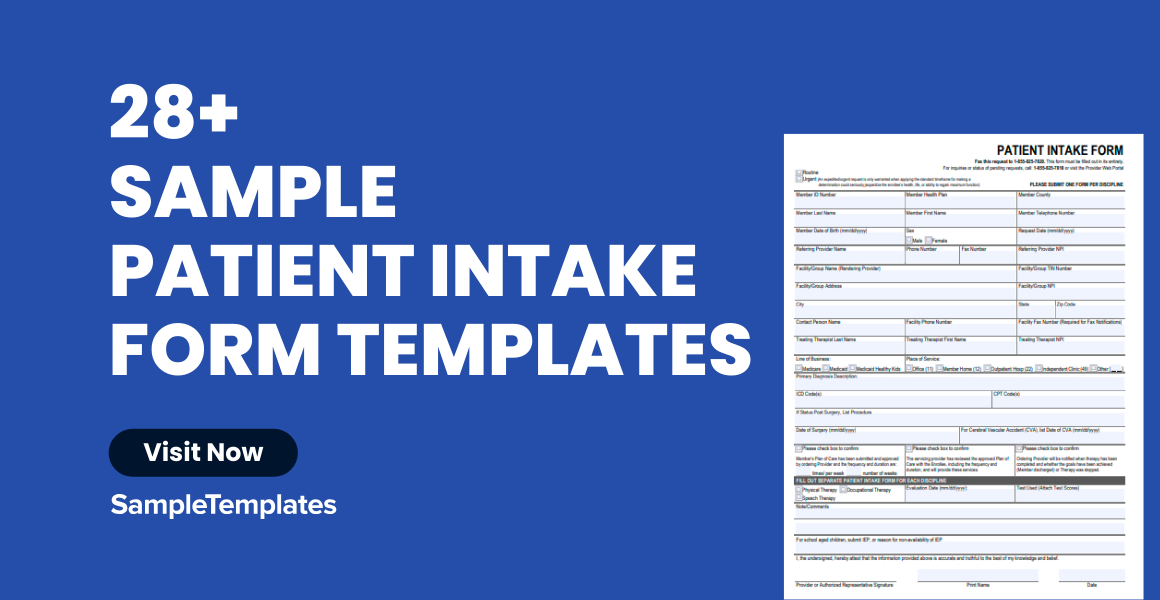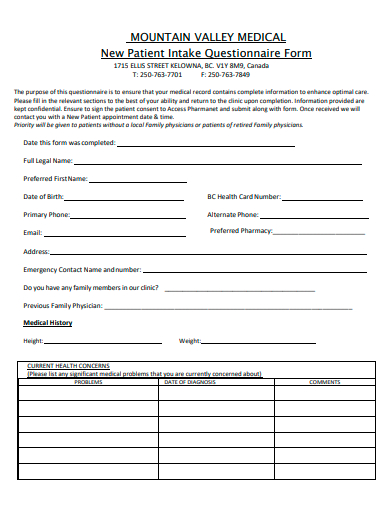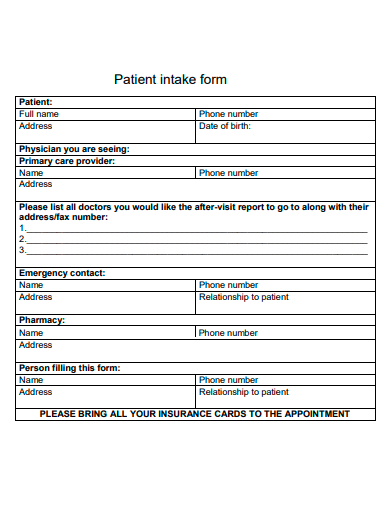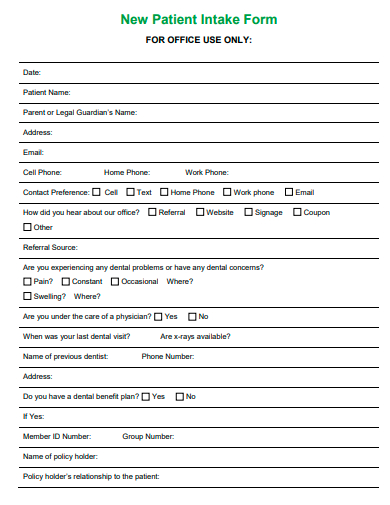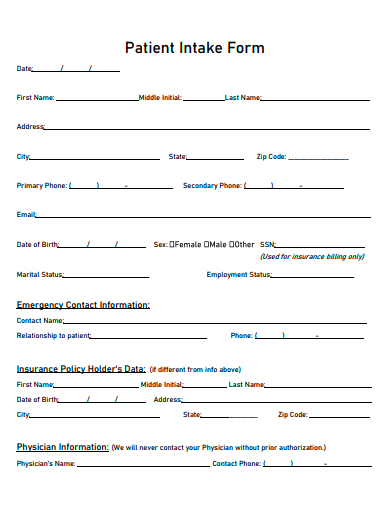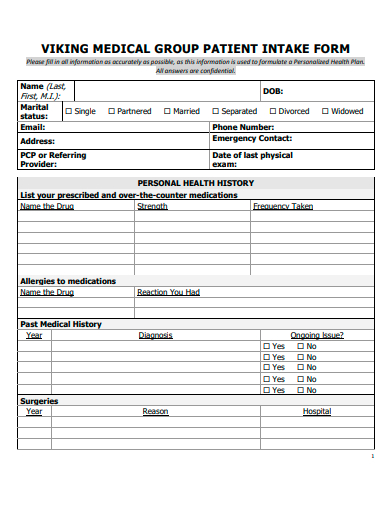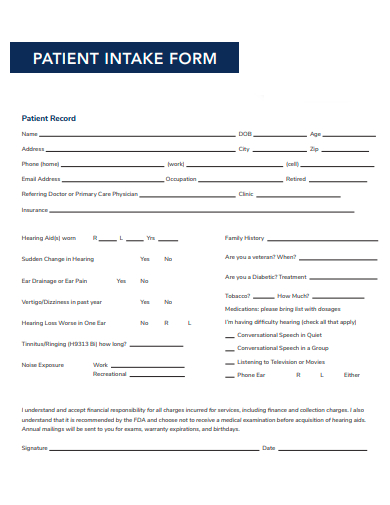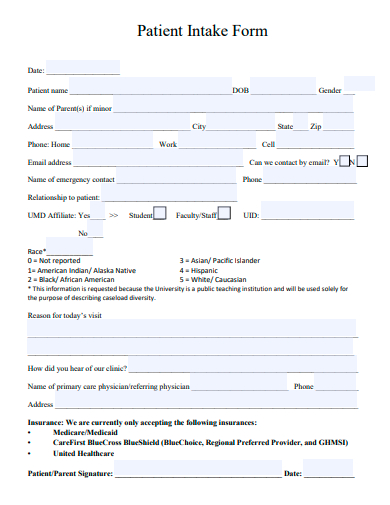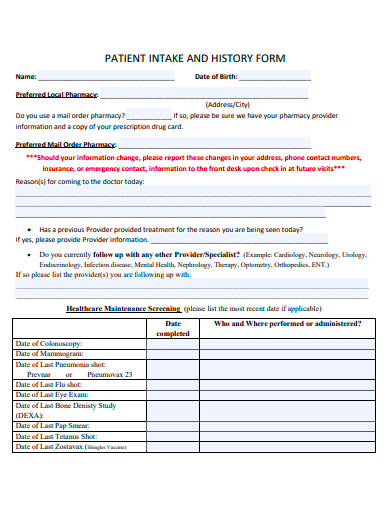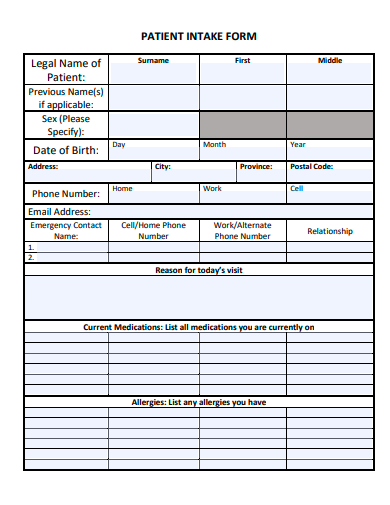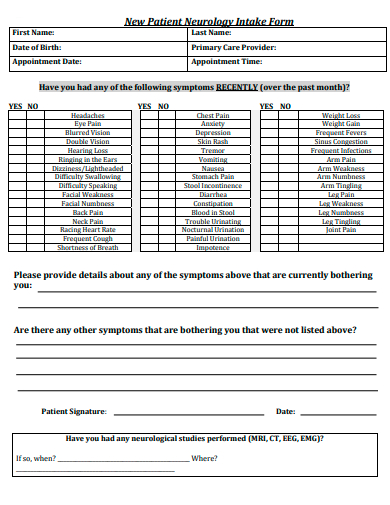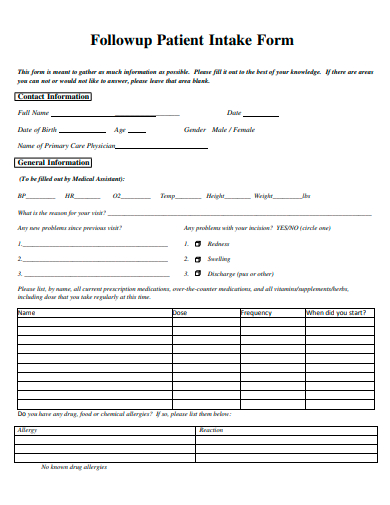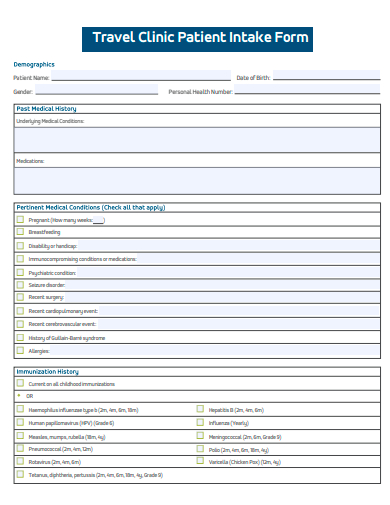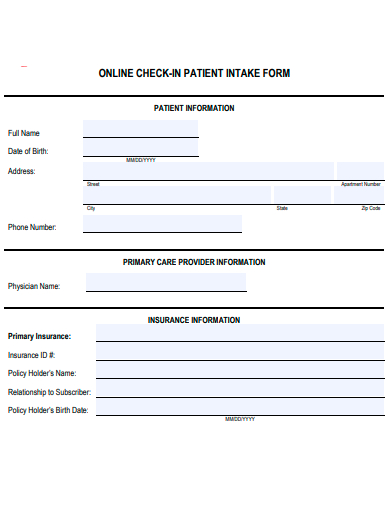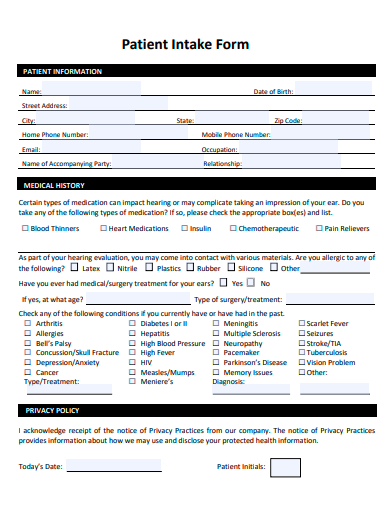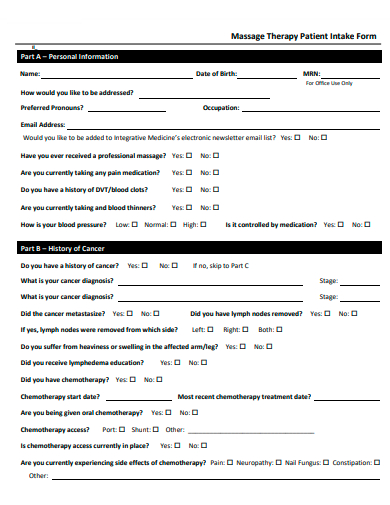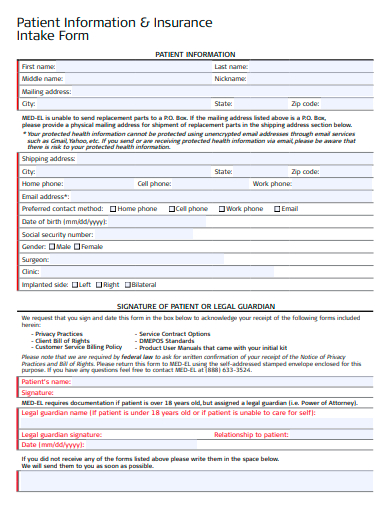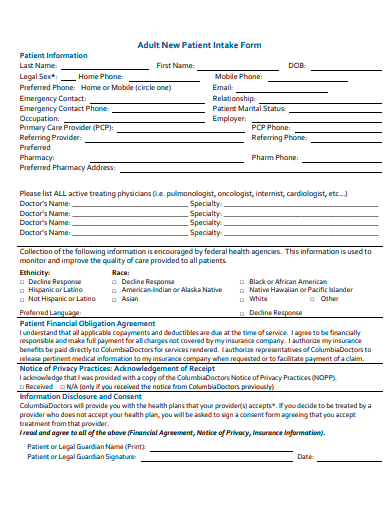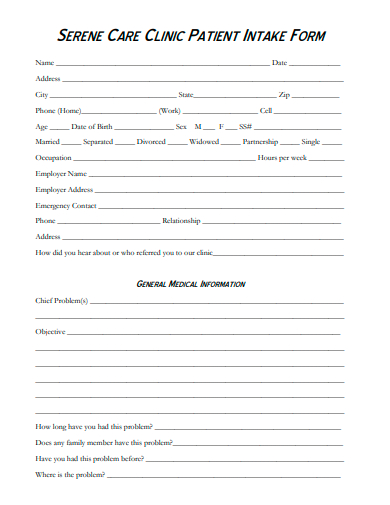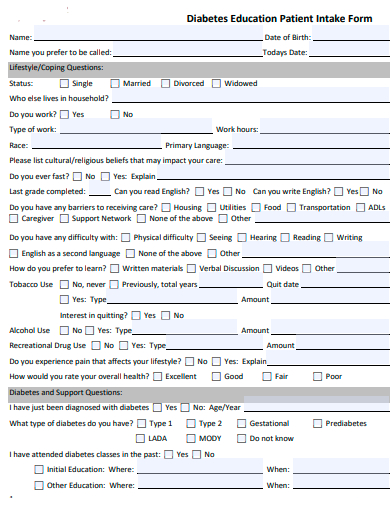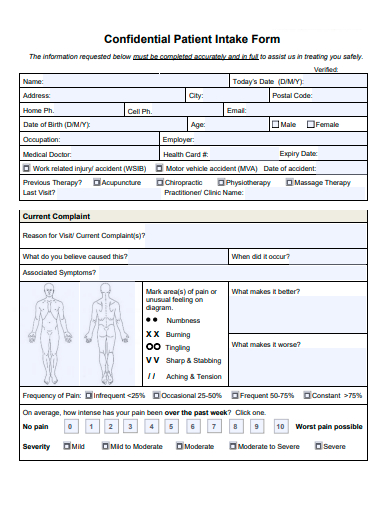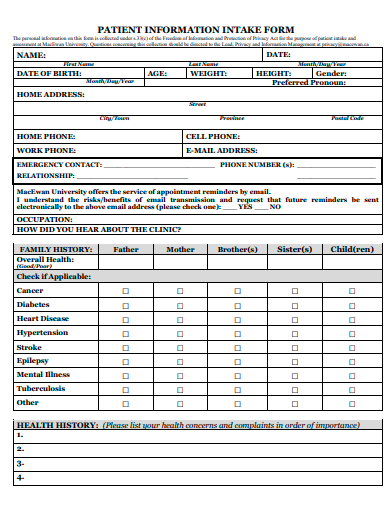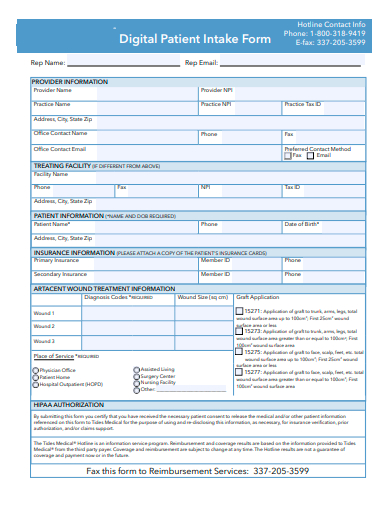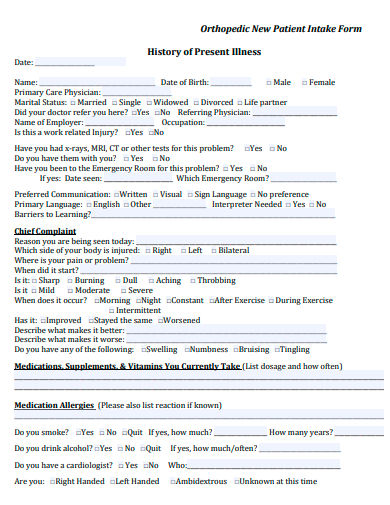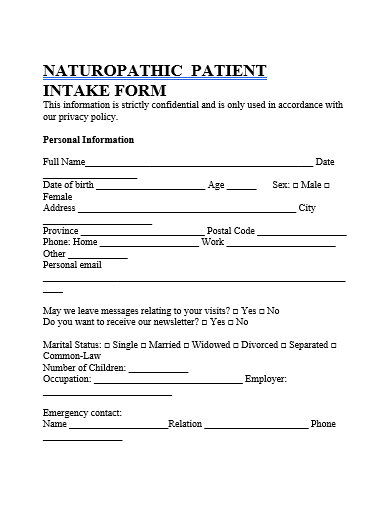Charting a new course in healthcare? Begin with our Sample Patient Intake Form. Meticulously structured to grasp every pivotal patient detail, Intake form sets the stage for exceptional medical care. For practitioners who value comprehensive onboarding and impeccable record accuracy, our template emerges as an unparalleled choice. Elevate your patient engagement and embrace a holistic, streamlined approach today with our standout intake form.
28+ Patient Intake Form Samples
1. Service Intake Form Template
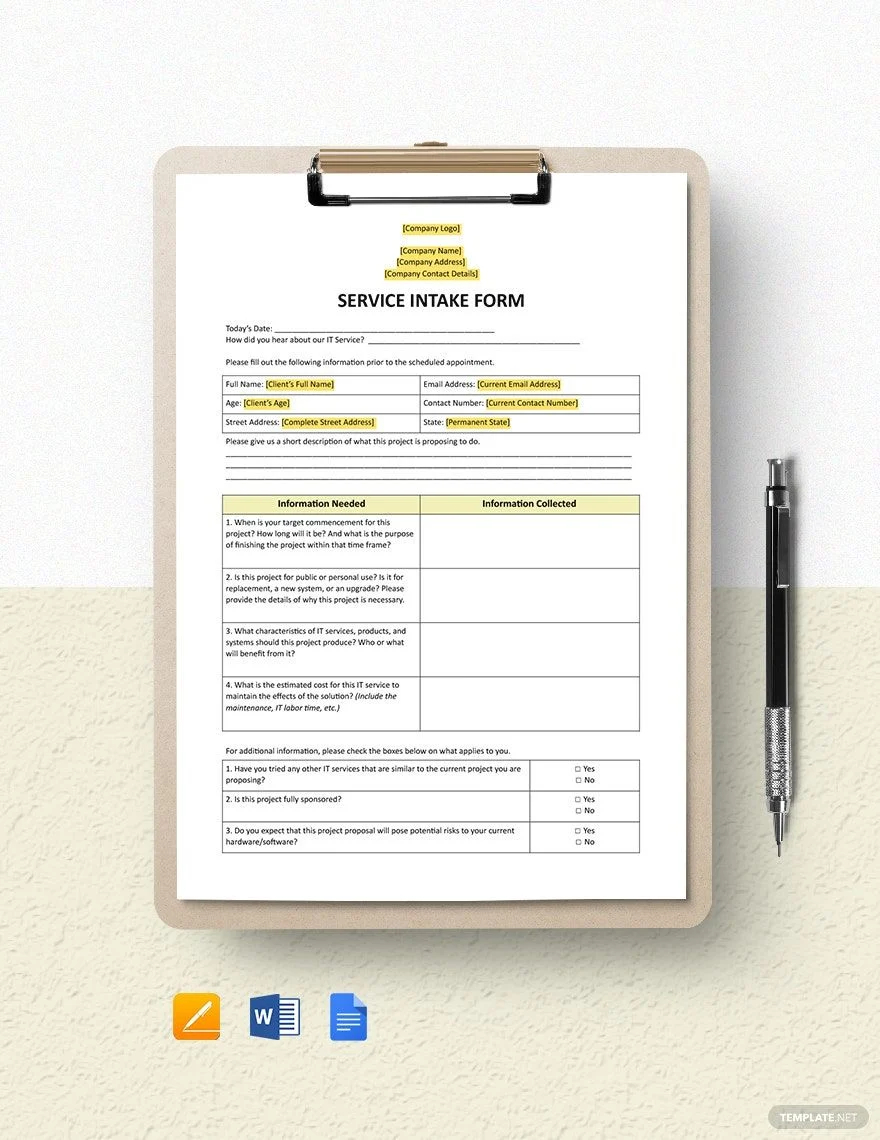
2. Patient Intake Form Template
3. New Patient Intake Questionnaire Form Template
4. Basic Patient Intake Form Template
5. New Patient Intake Form Template
6. Patient Intake Form Example
7. Medical Group Patient Intake Form Template
8. Formal Patient Intake Form Template
9. Outpatient Therapy Patient Intake Form Template
10. Standard Patient Intake Form Template
What is an Intake Form in Healthcare?
At its core, an intake form in healthcare is a foundational document used by medical practitioners and healthcare facilities. It captures critical information about a patient, serving as the initial touchpoint between the patient and the healthcare provider.
The Information Landscape
Typically, this form includes personal details such as the patient’s name, date of birth, address, and contact information. More importantly, it delves into medical histories, allergies, current medications, and primary reasons for the visit. This in-depth data collection ensures that healthcare providers can offer the safest and most personalized care possible.
Benefits to Patients and Providers
From the patient’s perspective, the intake form serves as a way to communicate their health concerns, conditions, and medical background, ensuring that their healthcare journey begins on an informed note. For the healthcare provider, it provides a snapshot of the patient’s health, allowing for a quick reference, which can be particularly useful during initial consultations.
A Shift Towards Digitization
With the advent of electronic health records (EHR) and telehealth platforms, many intake forms have transitioned from paper to digital formats. Digital intake forms are often more efficient, reducing the risk of data entry errors and simplifying storage and retrieval. Patients can often complete these forms online before their visit, cutting down on wait times and streamlining the check-in process.
Ensuring Patient Privacy
It’s imperative to note that while intake forms collect personal and sensitive information, healthcare providers are bound by regulations like the Health Insurance Portability and Accountability Act (HIPAA) to protect this data. Thus, these forms play a pivotal role in patient care while respecting and safeguarding individual privacy.
How Do I Create a Professional Intake Form?
Before diving into the creation process, it’s essential to understand the purpose of your intake form. Do you need it for general medical practice, or is it for a specialized field like dentistry or psychiatry? Each specialty will require different sets of information. Start by listing out the essential data points you need to collect.
Choosing the Right Format
While paper forms are traditional, consider using digital formats for added efficiency. Platforms like Google Forms, Microsoft Forms, or specialized EHR software can help in creating digital intake forms. They not only ensure easy data collection but also aid in data analysis and storage.
Ask Clear and Concise Questions
It’s crucial to word your questions clearly to prevent any misunderstandings. Avoid using medical jargon that patients might not understand. For instance, instead of asking if a patient is “hypertensive,” inquire if they have “high blood pressure.”
Sectioning for Simplicity
To make the form user-friendly, divide it into sections. Common sections include Personal Information, Medical History, Current Medications, Allergies, and the Reason for the Visit. Providing clear sections helps patients navigate the form and ensures that they don’t miss out on any critical details.
Include a Privacy Statement
Given the sensitive nature of the information collected, always include a statement detailing how the patient’s data will be used and stored. Reassure patients of their privacy and inform them of their rights concerning their medical data.
Test and Refine
Before officially using your intake form, test it with a small group of patients or colleagues. Gather feedback on its clarity, length, and ease of use. This feedback phase is critical, as it can highlight any potential issues or areas of confusion that you might have overlooked.
Regularly Update
Medical practices and the needs of healthcare providers can evolve over time. Ensure that you periodically review and update your intake form to accommodate any new data requirements or to enhance its user-friendliness based on feedback.
11. Patient Intake and History Form Template
12. Printable Patient Intake Form Template
13. New Patient Neurology Intake Form Template
14. Followup Patient Intake Form Template
15. Simple Patient Intake Form Template
16. Travel Clinic Patient Intake Form Template
17. Online Check-In Patient Intake Form Template
18. Draft Patient Intake Form Template
19. Massage Therapy Patient Intake Form Template
20. Patient Information and Insurance Intake Form Template
21. Urgent Care Patient Intake Form Template
22. Adult New Patient Intake Form Template
23. Clinic Patient Intake Form Template
24. Diabetes Education Patient Intake Form Template
25. Confidential Patient Intake Form Template
26. Patient Information Intake Form Template
27. Digital Patient Intake Form Template
28. Orthopedic New Patient Intake Form Template
29. Patient Intake Form in DOC
What is Included in a Patient Intake Form?
A patient intake form, often the first document presented to patients upon their arrival at a healthcare facility, is crucial for gathering foundational and health-specific information. Here’s a breakdown of what’s typically included:
Personal Information: This includes the basics such as the patient’s full name, date of birth, address, contact numbers, email, and emergency contact details.
Insurance Details: Information about the patient’s health insurance provider, policy number, and any secondary insurance if applicable.
Primary Reason for Visit: A brief section where patients can describe the main reason for their appointment or any immediate health concerns.
Medical History: A comprehensive section detailing past surgeries, hospitalizations, chronic diseases, and other health-related experiences. This might also include questions about family medical history, especially concerning hereditary diseases.
Current Medications: Information on any drugs the patient is currently taking, including dosage and frequency. This also encompasses over-the-counter medications, herbal supplements, and vitamins.
Allergies: A list of known allergies, especially to medications, but also including food, materials (like latex), and environmental factors.
Lifestyle Information: Questions related to diet, exercise, alcohol consumption, smoking, recreational drug use, and other lifestyle habits that can impact health.
Review of Systems: A section where patients can indicate if they’re experiencing symptoms across various body systems, such as respiratory, cardiovascular, or gastrointestinal.
Privacy Acknowledgment: A statement that details how personal and medical information will be used, stored, and protected. This often requires a signature to acknowledge understanding and consent.
Financial Policy and Consent: Details about payment policies, missed appointments, and other administrative aspects. Patients usually need to sign this, indicating they understand and agree to the facility’s policies.
Benefits of a Patient Intake Form
Streamlined Patient Onboarding: Intake forms simplify the initial process of getting to know the patient, allowing healthcare providers to quickly understand the patient’s background and current health status.
Enhanced Patient Safety: By documenting allergies, current medications, and medical history, providers can avoid potential medical errors or drug interactions.
Time Efficiency: With all essential data in one place, healthcare professionals can reduce the time spent gathering verbal histories or other details, leading to more focused consultations.
Personalized Care: A detailed intake form allows healthcare providers to tailor their approach and treatment plans according to the individual needs and history of the patient.
Legal Protection: In cases of misunderstandings or disputes, a signed intake form can serve as evidence that the patient provided certain information and consented to certain policies and procedures.
Facilitated Continuity of Care: If a patient changes healthcare providers or sees specialists, the intake form offers a comprehensive snapshot of the patient’s health, ensuring seamless care transitions.
Data Organization: Especially in its digital format, the intake form makes it easier to organize, store, retrieve, and analyze patient data, streamlining administrative tasks and enhancing overall healthcare delivery.
In conclusion, a patient intake form is a crucial tool in the healthcare industry, serving both operational and clinical purposes. By capturing pertinent information upfront, it paves the way for efficient, safe, and individualized care.
Related Posts
Sample Sworn Affidavit Forms
Vehicle Inspection Forms Samples & Templates
Sample Employee Advance Forms
Sample Child Travel Consent Forms
Sample Testimonial Request Forms
Sample Employee Details Forms
Sample Divorce Forms
Sample Attestation Forms
Employee Performance Appraisal Form Templates
FREE 9+ Sample Presentation Evaluation Forms in MS Word
FREE 10+ School Admission Form Samples & Templates in MS Word | PDF
FREE 30+ Patient Consent Form Samples in PDF | MS Word
FREE 10+ Sample Sign Off Form Templates in PDF | MS Word
FREE 11+ Sample Medical Consultation Forms in PDF | MS Word
FREE 8+ Sample Donation Forms in PDF | MS Word
